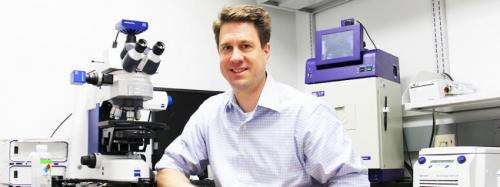Compound protects brain cells after traumatic brain injury

A new class of compounds has now been shown to protect brain cells from the type of damage caused by blast-mediated traumatic brain injury (TBI). Mice that were treated with these compounds 24-36 hours after experiencing TBI from a blast injury were protected from the harmful effects of TBI, including problems with learning, memory, and movement.
Traumatic brain injury caused by blast injury has emerged as a common health problem among U.S. servicemen and women, with an estimated 10 to 20 percent of the more than 2 million U.S. soldiers deployed in Iraq or Afghanistan having experienced TBI. The condition is associated with many neurological complications, including cognitive and motor decline, as well as acquisition of psychiatric symptoms like anxiety and depression, and brain tissue abnormalities that resemble Alzheimer's disease.
"The lack of neuroprotective treatments for traumatic brain injury is a serious problem in our society," says Andrew Pieper, M.D., Ph.D., senior study author and associate professor of psychiatry, neurology, and radiation oncology at the University of Iowa Carver College of Medicine. "Everyone involved in this work is motivated to find a way to offer hope for patients, which today include both military personnel and civilians, by establishing a basis for a new treatment to combat the deleterious neuropsychiatric outcomes after blast injury."
It is known that TBI, as well as certain neurodegenerative diseases, damages axons – the tendril-like fibers that sprout from brains cells (neurons) and form the connections called synapses. In TBI, axon damage is followed by death of the neuron. The new study, published Sept. 11 in the journal Cell Reports, shows that a group of compounds, called the P7C3 series, blocks axon damage and preserves normal brain function following TBI.
Pieper led the team of scientists that discovered the P7C3 compound several years ago at UT Southwestern Medical Center. Subsequent studies showed that the root compound and its active analogs protect newborn neurons from cell death and also protect mature neurons in animal models of neurodegenerative diseases, including Parkinson's disease and amyotrophic lateral sclerosis (ALS).
The researchers have also previously shown efficacy of P7C3 molecules in brain injury due to concussion, and plan to investigate whether these compound might be applicable in stroke as well, given that there appear to be common factors mediating neuronal cell death in these conditions.
By tweaking the structure of the original P7C3 compound, Pieper and his colleagues Joseph Ready, Ph.D., and Steven McKnight, Ph.D., at UT Southwestern Medical Center, have further improved its potency and drug-like properties. In the latest study, Pieper's team at the UI Carver College of Medicine, including co-first authors graduate student Terry Yin, senior technician Jeremy Britt, and graduate student Hector De Jesus-Cortes, tested the neuroprotective effects of the newest version, (-)-P7C3-S243, which can be given orally, in mice with blast-induced TBI.
In the study, blast-induced TBI caused learning, memory, and movement problems in the mice, which resemble the problems experienced by people affected by TBI. The researchers found that (-)-P7C3-S243 prevented acute memory and learning impairment caused by TBI. The compound also prevented TBI-associated balance and coordination problems in mice exposed to blast-injury. By examining the brain tissue at a cellular level, the team also found that the protection afforded to brain functions after injury was matched by preservation of normal neuronal axon structure and synaptic neurotransmission.
Importantly, the compound still produced its protective effects even when treatment was delayed until 24 to 36 hours after the blast injury.
"Seeing protection even when the compound was given this long after injury was important because it represents a liberal window of time within which almost all patients would be expected to be able to access treatment after injury," Pieper says.
The team also found that learning, memory, and coordination problems caused by the TBI persisted in untreated mice at least eight months after the single injury occurred, suggesting that the compound actually prevented these problems rather simply speeding up a normal recovery process.
In a separate study led by Pieper's colleagues McKnight and Ready at UT Southwestern, and also published on Sept. 11 in the journal Cell, the team has identified the biological mechanism by which P7C3 compounds act in the brain. The compounds activate the molecular pathway that preserves neuronal levels of an energy molecule known as nicotinamide adenine dinucleotide (NAD).
"Based on the well-established role of NAD in axonal degeneration, the ability of (-)-P7C3-S243 to protect mice after blast-mediated traumatic brain injury is likely related to preservation of NAD levels," Pieper explains. "Now that we understand the mechanism of action of the P7C3 class of compounds, we can see why they should have therapeutic utility in an unusually broad spectrum of neurodegenerative conditions, without impeding any of a number of other normal forms of cell death.
"Our ultimate goal is to facilitate development of a new class of neuroprotective drugs with wide applicability to treating patients with TBI and other currently untreatable forms of neurodegeneration," he adds.














